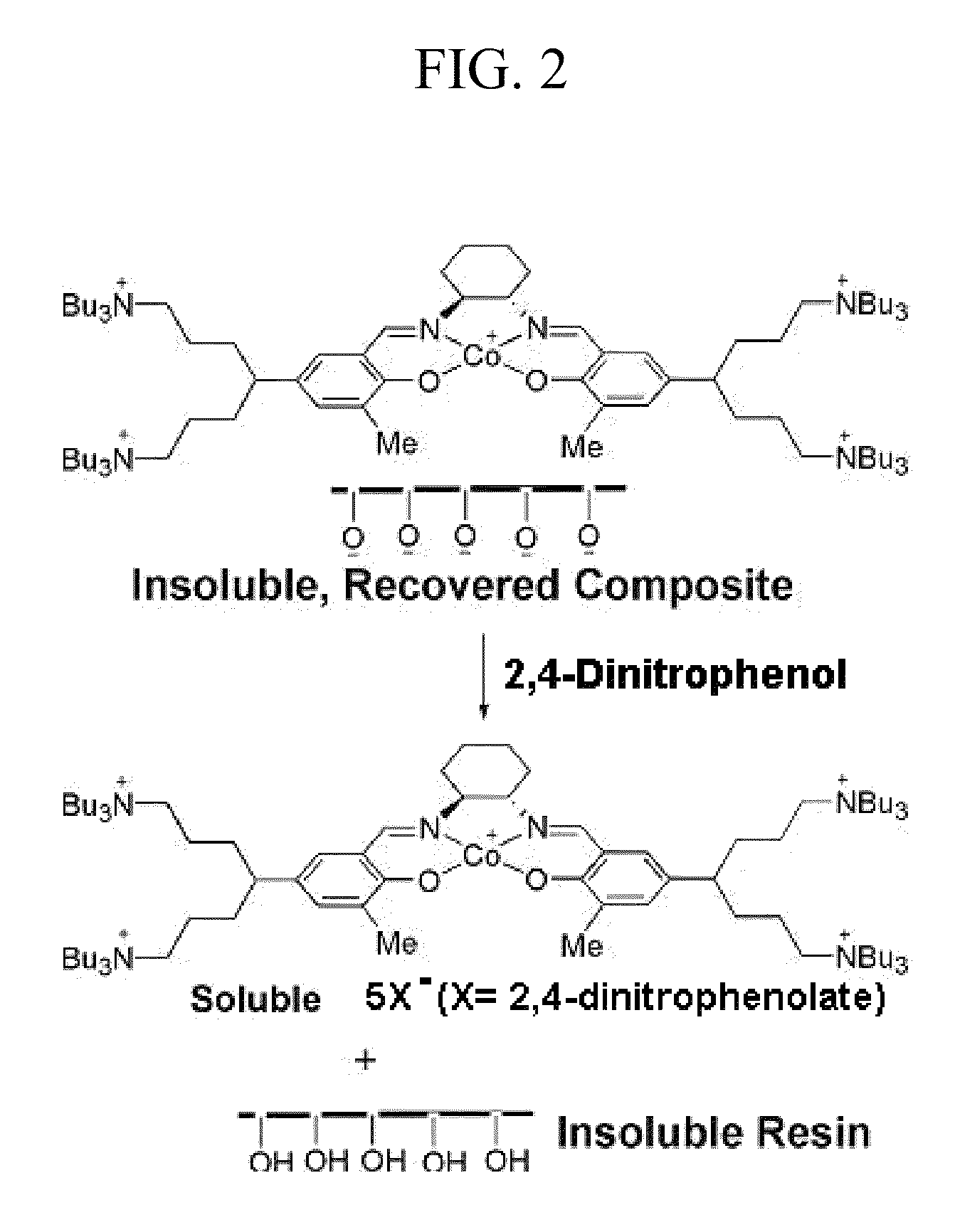Process for producing polycarbonates and a coordination complex used therefor
a technology of polycarbonate and coordination complex, which is applied in the preparation of isocyanic acid derivatives, physical/chemical process catalysts, organic compounds/hydrides/coordination complex catalysts, etc., can solve the problems of low activity, conceptually difficult to achieve a high turnover number (ton) under these mechanisms, and commercially availabl
- Summary
- Abstract
- Description
- Claims
- Application Information
AI Technical Summary
Benefits of technology
Problems solved by technology
Method used
Image
Examples
example 1
Preparation of the complex of formula (6a)
[0170]
(1) Synthesis of Compound 1
[0171]2-tent-Butylphenol (40 g, 266 mmol) was dissolved in carbon disulfide (50 mL), and bromine (42.6 g, 266 mmol) was slowly added thereto over 2 hours using a dropping funnel while stirring at 0° C. After allowing the reaction to proceed for 12 hours, the solvent was removed using a rotary vacuum evaporator. The residue was distilled under a reduced pressure at 65-68° C. to obtain Compound 1 (yield: 90%).
(2) Synthesis of Compound 2
[0172]Compound 1 (2.7 g, 12 mmol) was dissolved in tetrahydrofuran (100 mL) under a nitrogen atmosphere, and tert-BuLi (14.5 g, 1.7 M pentane solution) was added thereto using a syringe while stirring at −78° C. The reaction was allowed to proceed at −78° C. for 2 hours, and chloro(3-chloropropyl)dimethylsilane (4.639 g, 27.1 mmol) was added to the reaction mixture using a syringe. The resulting solution was slowly warmed to room temperature over 2 hours, 150 mL of water was adde...
example 2
Preparation of the Complex of Formula (6b)
[0177]
(1) Synthesis of Compound 6
[0178]Compound 6 was synthesized from Compound 3 by using the known procedure [T. V. Hansen, L. Skatteböl, Tetrahedron Lett. 2005, 46, 3829]. The resulting product was purified by column chromatography using a 40:1 mixture of methylene chloride and ethanol to obtain Compound 6. IR (KBr): 3409 (OH), 1627 (C═N) cm−1. 1H NMR (CDCl3): δ 14.16 (s, 1H, OH), 13.62 (s, 1H, OH), 8.36 (s, 1H, CH═N), 8.32 (s, 1H, CH═N), 7.30 (d, J=2.4 Hz, 1H, m-H), 7.29 (d, J=1.6 Hz, 1H, m-H), 7.16 (d, J=1.6 Hz, 1H, m-H), 6.99 (d, J=2.4 Hz, 1H, m-H), 3.42-3.32 (m, 2H, CHN), 3.30 (t, J=8.4 Hz, 8H, NCH2), 2.13-1.56 (m, 8H, cyclohexyl-CH2), 1.68-1.55 (m, 8H, NCH2CH2), 1.41 (s, 9H, tert-BuCH3), 1.40 (s, 9H, tert-BuCH3), 1.39-1.34 (m, 6H, NCH2CH2CH2), 1.24 (s, 9H, tert-BuCH3), 0.93 (t, J=7.2 Hz, 9H, CH3), 0.77-0.71 (m, 2H, SiCH2), 0.27 (s, 3H, SiCH3), 0.25 (s, 3H, SiCH3) ppm. 13C {1H} NMR (CDCl3): δ 165.45, 165.08, 161.48, 157.67, 139.73, 13...
example 3
Preparation of the Complex of Formula (6c)
[0180]
(1) Synthesis of Compound 8
[0181]Compound 1 (15 g, 65.5 mmol), dihydropyran (6.33 g, 75.3 mmol) and pyridinium p-toluenesulfonate (0.200 g) were dissolved in methylene chloride under a nitrogen atmosphere. The solution was stirred at room temperature for 19 hours. The solvent was removed and the residue was recrystallized with hexane to obtain Compound 8 as a white solid (yield: 72%).
(2) Synthesis of Compound 9
[0182]Compound 8 (14.6 g, 46.7 mmol) was dissolved in tetrahydrofuran (300 mL) at −78° C. under a nitrogen atmosphere, and n-BuLi (14.23 g, 51.34 mmol, 2.5 M hexane solution) was added thereto using a syringe. The reaction was allowed to proceed for 2 hours while stirring, and chlorodiphenylphosphine (10.3 g, 46.7 mmol) was added to the reaction mixture using a syringe. The resulting solution was slowly warmed to room temperature while stirring over 2 hours. The resulting solution was treated with ethyl acetate (100 mL) and water...
PUM
 Login to View More
Login to View More Abstract
Description
Claims
Application Information
 Login to View More
Login to View More - R&D
- Intellectual Property
- Life Sciences
- Materials
- Tech Scout
- Unparalleled Data Quality
- Higher Quality Content
- 60% Fewer Hallucinations
Browse by: Latest US Patents, China's latest patents, Technical Efficacy Thesaurus, Application Domain, Technology Topic, Popular Technical Reports.
© 2025 PatSnap. All rights reserved.Legal|Privacy policy|Modern Slavery Act Transparency Statement|Sitemap|About US| Contact US: help@patsnap.com



